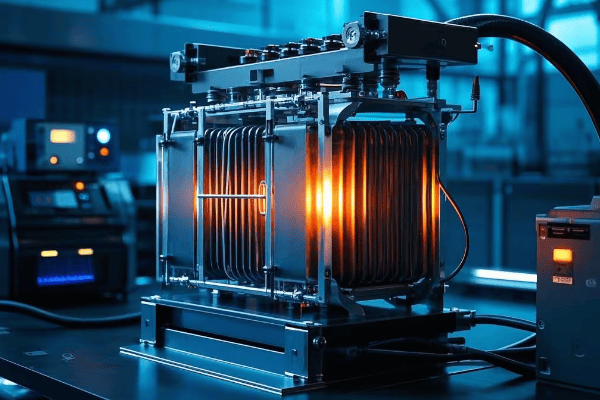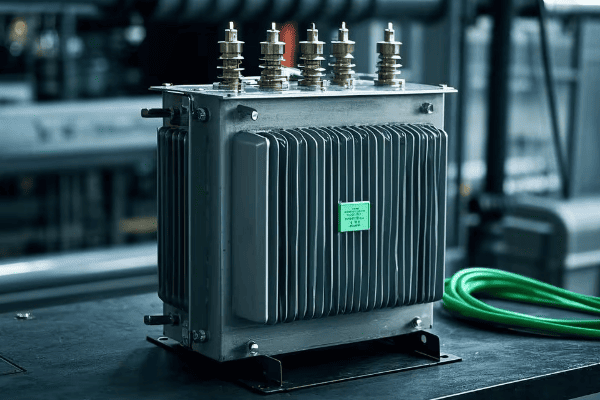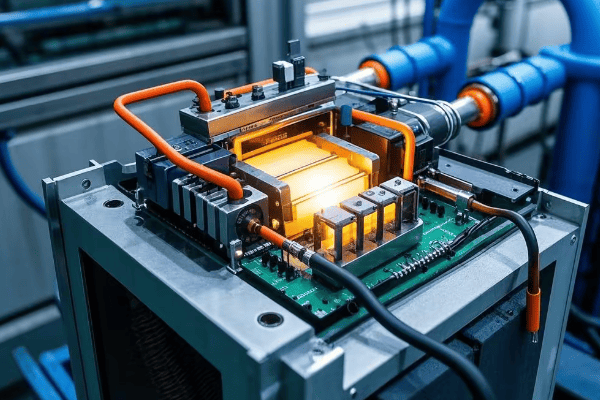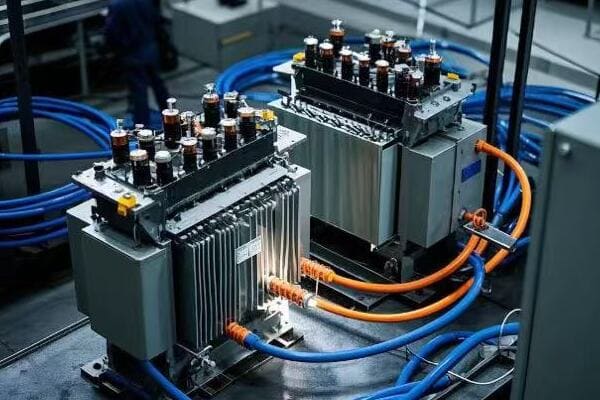Is your power grid ready for the future? The transformer technology you rely on today might be obsolete sooner than you think.
The future of step up and step down transformers is being shaped by AI, IoT, eco-friendly materials, and cutting-edge designs. These innovations promise to revolutionize power distribution, offering unprecedented efficiency, reliability, and sustainability. Stay ahead of the curve by understanding these game-changing trends.

As someone who's been in the transformer industry for over two decades, I've seen technology evolve rapidly. But what's coming next is truly revolutionary. In this article, I'll walk you through the most exciting developments that are set to transform our industry. Whether you're a seasoned engineer or a curious enthusiast, you'll find insights that will change how you think about power distribution.
Smart Transformers: The Integration of AI and IoT in Transformer Design?
Are your transformers still "dumb"? You might be missing out on a revolution that's already underway in power distribution.
Smart transformers, equipped with AI and IoT capabilities, are set to redefine power distribution. These intelligent devices can self-diagnose, adapt to changing load conditions, and communicate in real-time, significantly improving grid efficiency and reliability.

I recently visited a substation that had just upgraded to smart transformers. The difference was night and day. Let me show you why these intelligent devices are the future of our industry.
The Brain of Smart Transformers: AI Integration
Artificial Intelligence is revolutionizing transformer operation:
-
Real-time Load Management:
- AI algorithms predict and balance loads across the grid
- Adaptive voltage regulation based on demand forecasts
- Intelligent power routing to minimize losses
-
Fault Prediction and Prevention:
- Machine learning models analyze data to predict potential failures
- Proactive maintenance scheduling based on AI insights
- Automatic fault isolation to prevent cascading failures
-
Energy Efficiency Optimization:
- AI-driven efficiency improvements in power conversion
- Smart load shedding during peak demand periods
- Optimized transformer lifecycle management
The Nervous System: IoT Connectivity
IoT transforms transformers into communicative grid elements:
-
Real-time Monitoring:
- Continuous data streaming on transformer health and performance
- Remote access for engineers to diagnose issues
- Integration with smart grid management systems
-
Inter-transformer Communication:
- Transformers share load information to optimize grid performance
- Coordinated response to power quality issues
- Seamless integration of distributed energy resources
-
Data-driven Decision Making:
- Big data analytics for long-term grid planning
- Predictive maintenance based on historical and real-time data
- Performance benchmarking across the transformer fleet
Smart Transformer Components
| Component | Function | AI/IoT Benefit |
|---|---|---|
| Sensors | Monitor temperature, oil quality, load | Real-time data for AI analysis |
| Microprocessors | Process data and run AI algorithms | On-site intelligence and decision making |
| Communication Modules | Connect to grid network and control centers | Enable remote monitoring and control |
| Smart Switches | Dynamically adjust transformer parameters | Automated optimization of performance |
| Energy Storage | Integrated batteries or supercapacitors | Load balancing and power quality improvement |
The integration of AI and IoT in transformers is not just a technological upgrade; it's a paradigm shift in how we manage power distribution. In my experience, smart transformers can reduce downtime by up to 70% and improve energy efficiency by 15-20%.
One particularly impressive case I encountered was a smart transformer system that predicted and prevented a potential city-wide blackout. The AI detected an unusual pattern in load distribution and preemptively rerouted power, averting a major crisis. This level of proactive management was simply impossible with traditional transformers.
However, the transition to smart transformers isn't without challenges. Cybersecurity becomes a critical concern when your power infrastructure is connected to the internet. Additionally, the initial investment can be significant, though the long-term benefits often outweigh the costs.
As we move forward, I believe that smart transformers will become the standard, not the exception. Utilities and industries that adopt this technology early will have a significant advantage in terms of reliability, efficiency, and customer satisfaction. The future of power distribution is intelligent, connected, and adaptive – and it's arriving faster than many of us realize.
Eco-Friendly Innovations: Sustainable Materials and Energy-Efficient Designs?
Are environmental concerns keeping you up at night? The transformer industry is stepping up to the challenge with groundbreaking eco-friendly solutions.
The future of transformer technology is green. From biodegradable insulating fluids to energy-efficient core materials, eco-friendly innovations are reducing environmental impact while improving performance. These sustainable designs are not just good for the planet – they're good for business.

I recently worked on a project that replaced old transformers with new eco-friendly models. The results were astounding, both in terms of performance and environmental impact. Let me share what I've learned about these game-changing innovations.
Sustainable Insulating Materials
The heart of eco-friendly transformer design lies in its insulation:
-
Biodegradable Transformer Oils:
- Plant-based oils that are non-toxic and easily biodegradable
- Improved fire safety due to higher flash points
- Longer lifespan, reducing the need for oil changes
-
Solid Insulation Alternatives:
- Cellulose-based materials from sustainable forests
- Synthetic esters with excellent thermal properties
- Hybrid insulation systems combining the best of different materials
-
Recycled and Recyclable Components:
- Use of recycled metals in transformer cores and windings
- Design for easy disassembly and recycling at end-of-life
- Biodegradable packaging for transformer components
Energy-Efficient Core Designs
Innovative core designs are pushing the boundaries of efficiency:
-
Advanced Core Materials:
- Amorphous metal cores with ultra-low core losses
- Nano-crystalline materials for high-frequency applications
- High-grade silicon steel with optimized grain orientation
-
Core Construction Techniques:
- Step-lap core designs for reduced noise and improved efficiency
- Wound cores for smaller distribution transformers
- Hybrid core designs combining different materials for optimal performance
-
Efficiency Standards and Certifications:
- Compliance with stringent energy efficiency regulations
- Eco-design considerations throughout the manufacturing process
- Third-party certifications for environmental performance
Comparison of Eco-Friendly Technologies
| Technology | Environmental Benefit | Performance Impact | Cost Consideration |
|---|---|---|---|
| Biodegradable Oils | Reduced pollution risk | Improved cooling, longer life | Higher initial cost, lower maintenance |
| Amorphous Metal Cores | Lower energy losses | Increased efficiency | Higher material cost, energy savings |
| Recycled Materials | Reduced raw material use | Comparable to new materials | Potential cost savings |
| Solid Insulation | No oil leaks, easier disposal | Good thermal performance | Higher initial cost, longer lifespan |
The shift towards eco-friendly transformer technology is not just about compliance with environmental regulations – it's about creating superior products. In my experience, these green innovations often lead to unexpected benefits.
For instance, I worked on a project where we replaced mineral oil with a biodegradable ester fluid in a substation near a sensitive wetland area. Not only did this eliminate the environmental risk, but we also saw a 20% increase in the transformer's overload capacity due to the ester's superior thermal properties.
Another fascinating development I've been following is the use of bio-based nanofluid coolants. These fluids, derived from vegetable oils and enhanced with nanoparticles, are showing promising results in improving cooling efficiency while being completely biodegradable.
However, it's important to note that adopting these eco-friendly technologies often requires a shift in mindset. The initial costs can be higher, and there may be a learning curve in terms of maintenance and operation. But in the long run, the benefits to both the environment and operational efficiency are substantial.
As we move towards a more sustainable future, I believe that eco-friendly transformer designs will become the norm rather than the exception. Companies that invest in these technologies now will not only be ahead of regulatory curves but will also benefit from improved performance and public perception. The future of transformer technology is not just smart – it's green.
Solid-State Transformers: Revolutionizing Power Distribution?
Have you heard about the technology that could make traditional transformers obsolete? Solid-state transformers are set to turn the power distribution industry on its head.
Solid-state transformers (SSTs) represent a quantum leap in power distribution technology. By replacing magnetic components with power electronics, SSTs offer unprecedented control over power flow, improved efficiency, and reduced size. This innovation could reshape our entire approach to grid management.

I recently had the opportunity to work with a prototype SST, and the experience was eye-opening. Let me share why I believe this technology is the future of power distribution.
The Core of SST Technology
Understanding the fundamental differences between SSTs and traditional transformers:
-
Power Electronic Building Blocks (PEBBs):
- High-frequency switching devices replace magnetic cores
- Modular design allows for scalability and flexibility
- Direct AC-DC-AC conversion enables precise power control
-
Advanced Control Systems:
- Real-time adjustment of voltage, frequency, and phase
- Ability to handle bidirectional power flow
- Integration of power quality improvement functions
-
Compact Design:
- Significant reduction in size and weight compared to traditional transformers
- Potential for integration into existing infrastructure
- Improved portability for mobile and temporary power solutions
Advantages of Solid-State Transformers
The benefits of SSTs extend far beyond simple power conversion:
-
Enhanced Grid Stability:
- Rapid response to grid disturbances
- Voltage sag compensation and harmonic filtering
- Seamless integration of renewable energy sources
-
Improved Energy Efficiency:
- Reduced losses in power conversion
- Optimized power flow management
- Ability to operate at peak efficiency across various load conditions
-
Smart Grid Enabler:
- Built-in communication and control capabilities
- Support for microgrid and nanogrid architectures
- Enhanced data collection for grid analytics
Comparison: SSTs vs. Traditional Transformers
| Aspect | Solid-State Transformer | Traditional Transformer |
|---|---|---|
| Size and Weight | Significantly smaller and lighter | Larger and heavier |
| Power Quality Control | Advanced, real-time control | Limited control capabilities |
| Efficiency | High efficiency across load range | Peak efficiency at specific loads |
| Maintenance | Minimal moving parts, easier maintenance | Regular oil and component maintenance |
| Smart Grid Integration | Built-in smart features | Requires additional equipment |
| Cost | Currently higher, expected to decrease | Well-established, lower initial cost |
The potential of solid-state transformers is truly revolutionary. In my work with the prototype, I was amazed by its ability to handle complex power quality issues that would have required multiple devices with a traditional setup.
One particularly impressive feature was its response to a simulated grid fault. The SST detected the issue and adjusted its output in milliseconds, maintaining stable power to critical loads that would have been disrupted with a conventional transformer.
However, it's important to note that SST technology is still in its early stages. There are challenges to overcome, particularly in terms of cost and long-term reliability. The high-frequency switching components can generate electromagnetic interference, requiring careful shielding and design considerations.
Despite these challenges, I'm convinced that solid-state transformers represent the future of power distribution. Their ability to provide precise power control, improve grid stability, and facilitate the integration of renewable energy sources makes them an essential technology for the smart grids of tomorrow.
As we move forward, I expect to see increased adoption of SSTs, particularly in applications that require advanced power management or where space is at a premium. Utilities and industries that start exploring this technology now will be well-positioned to lead in the new era of smart, flexible power distribution.
Conclusion
The future of transformer technology is bright, with smart systems, eco-friendly designs, and solid-state innovations leading the way. These advancements promise improved efficiency, reliability, and sustainability in power distribution, shaping the smart grids of tomorrow.


